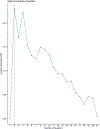Characterisation of the genetic relationship between the domains of sleep and circadian-related behaviours with substance use phenotypes
- PMID: 35754104
- PMCID: PMC10038127
- DOI: 10.1111/adb.13184
Characterisation of the genetic relationship between the domains of sleep and circadian-related behaviours with substance use phenotypes
Abstract
Sleep problems and substance use frequently co-occur. While substance use can result in specific sleep deficits, genetic pleiotropy could explain part of the relationship between sleep and substance use and use disorders. Here we use the largest publicly available genome-wide summary statistics of substance use behaviours (N = 79,729-632,802) and sleep/activity phenotypes to date (N = 85,502-449,734) to (1) assess the genetic overlap between substance use behaviours and both sleep and circadian-related activity measures, (2) estimate clusters from genetic correlations and (3) test processes of causality versus genetic pleiotropy. We found 31 genetic correlations between substance use and sleep/activity after Bonferroni correction. These patterns of overlap were represented by two genetic clusters: (1) tobacco use severity (age of first regular tobacco use and smoking cessation) and sleep health (sleep duration, sleep efficiency and chronotype) and (2) substance consumption/problematic use (drinks per day and cigarettes per day, cannabis use disorder, opioid use disorder and problematic alcohol use) and sleep problems (insomnia, self-reported short sleep duration, increased number of sleep episodes, increased sleep duration variability and diurnal inactivity) and measures of circadian-related activity (L5, M10 and sleep midpoint). Latent causal variable analyses determined that horizontal pleiotropy (rather than genetic causality) underlies a majority of the associations between substance use and sleep/circadian related measures, except one plausible genetically causal relationship for opioid use disorder on self-reported long sleep duration. Results show that shared genetics are likely a mechanism that is at least partly responsible for the overlap between sleep and substance use traits.
Keywords: genetic correlations; sleep; substance use.
© 2022 Society for the Study of Addiction.
Figures



Similar articles
-
Association between alcohol consumption and sleep traits: observational and mendelian randomization studies in the UK biobank.Mol Psychiatry. 2024 Mar;29(3):838-846. doi: 10.1038/s41380-023-02375-7. Epub 2024 Jan 18. Mol Psychiatry. 2024. PMID: 38233469
-
Sleep-related traits and attention-deficit/hyperactivity disorder comorbidity: Shared genetic risk factors, molecular mechanisms, and causal effects.World J Biol Psychiatry. 2021 Dec;22(10):778-791. doi: 10.1080/15622975.2021.1907719. Epub 2021 Apr 30. World J Biol Psychiatry. 2021. PMID: 33821771
-
Genetically predicted effects of 10 sleep phenotypes on revision of knee arthroplasty: a mendelian randomization study.J Orthop Surg Res. 2024 Sep 12;19(1):563. doi: 10.1186/s13018-024-05031-0. J Orthop Surg Res. 2024. PMID: 39267063 Free PMC article.
-
Sleep Management Among Patients with Substance Use Disorders.Med Clin North Am. 2018 Jul;102(4):733-743. doi: 10.1016/j.mcna.2018.02.012. Med Clin North Am. 2018. PMID: 29933826 Free PMC article. Review.
-
Adolescent substance use and its association to sleep disturbances: A systematic review.Sleep Health. 2019 Aug;5(4):382-394. doi: 10.1016/j.sleh.2019.06.001. Epub 2019 Jul 11. Sleep Health. 2019. PMID: 31303473
Cited by
-
Does sleep relate to next-day cannabis use during treatment? Findings from an adolescent and young adult motivational enhancement and cognitive behavioral therapy plus topiramate intervention.Drug Alcohol Depend. 2023 Dec 1;253:111006. doi: 10.1016/j.drugalcdep.2023.111006. Epub 2023 Oct 23. Drug Alcohol Depend. 2023. PMID: 37944198 Free PMC article.
-
Mental Health, Substance Use, and Related Factors Associated with Recent Use of Cannabis for Sleep: A Co-Twin Control Study.Behav Sleep Med. 2025 May 22:1-13. doi: 10.1080/15402002.2025.2508770. Online ahead of print. Behav Sleep Med. 2025. PMID: 40400361
-
The relations between chronotype, stressful life events, and impulsivity in the Adolescent Brain Cognitive Development (ABCD) study.J Psychiatr Res. 2023 Nov;167:119-124. doi: 10.1016/j.jpsychires.2023.10.030. Epub 2023 Oct 16. J Psychiatr Res. 2023. PMID: 37866325 Free PMC article.
-
Sleep-Related Predictors of Risk for Alcohol Use and Related Problems in Adolescents and Young Adults.Alcohol Res. 2024 Mar 14;44(1):02. doi: 10.35946/arcr.v44.1.02. eCollection 2024. Alcohol Res. 2024. PMID: 38500552 Free PMC article. Review.
-
Urine metabolomics analysis of sleep quality in deep-underground miners: A pilot study.Front Public Health. 2022 Aug 19;10:969113. doi: 10.3389/fpubh.2022.969113. eCollection 2022. Front Public Health. 2022. PMID: 36062104 Free PMC article.
References
Publication types
MeSH terms
Grants and funding
LinkOut - more resources
Full Text Sources
Medical

